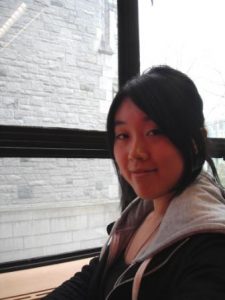A chemistry graduate student presenting a research talk would usually expect an audience from their close circle of chemistry colleagues studying a similar topic. However, when the research is about pollutants and chemical processes that affect air quality, climate, and health, the audience can draw in many more experts: chemists, engineers, and specialists in public health, computer modeling, geography, and policy.
In a UBC training program called CREATE-AAP (Collaborative Research and Training Experience – Atmospheric Aerosol Program), students learn to close the gap between researchers in a variety of areas who all study the particles in our atmosphere we call aerosols. The aim is for students in the program to communicate with scholars from outside their disciplines, and as a result, cultivate a broader understanding of the interrelatedness of concepts involving atmospheric aerosols, an integral skill required to tackle key environmental problems.
Some CREATE-AAP activities designed to give students opportunities to gain communication-focused competencies include:
- an annual symposium to share research in poster sessions and research talks with guest speakers from industry, government, and academia;
- an annual student seminar conference to present internship results and experiences that represent labs of other aerosol research groups at UBC;
- a graduate-level seminar course (CHEM540D) and a bi-weekly journal club to read and discuss diverse journal literature in an interdisciplinary group; and
- professional skills training workshops to enhance skills in public speaking, media communications, teaching, and project management.
These events regularly bring together students from up to six different departments at UBC.
As CREATE-AAP students take part in these activities, they exchange feedback on what works and what does not work in cross-discipline science communication. Take a scene in CHEM540D, the seminar course designed for the CREATE-AAP program’s graduate students. In a CHEM540D class, the audience lacks a common knowledge base of atmospheric chemistry, so a phrase such as “heterogeneous ice nucleation” has to be defined or it can lose the audience. Highly technical language is expected in a talk for chemistry colleagues or for scientific journals, but to an audience unfamiliar with the topic, technical knowledge can instead be introduced with clear visuals, logical flow, and adequate pacing. The challenge is to provide enough detail and depth without overwhelming their audience with jargon and acronyms.
When CREATE-AAP students practice adapting their language to a more general audience, they also learn to understand and relate perspectives from other disciplines into their own. For example, students studying the public health impacts around cookstove emissions in rural communities could relate to another student’s research focused on the mitigation perspective of the same topic. A geography student monitoring air pollution may collaborate with a chemistry student to analyze the composition and transport of pollutants. Learning to engage in interdisciplinary teams is a highly sought skill for employers in the environmental and health sectors.
Through exposure to other disciplines, CREATE-AAP students hone their interdisciplinary communication skills and underpin their expertise with a deeper appreciation of the range of perspectives on atmospheric aerosol research. When these students in chemistry, engineering, medicine, atmospheric sciences, or resource management walk into another research talk, they can all hope to see the relevance of each others’ works to their own studies and a better understanding of air quality, health, and climate.
 Allan Bertram is the Director of CREATE-AAP, an interdisciplinary atmospheric aerosol program funded through the NSERC CREATE program (2010-present). He is a professor in the Department of Chemistry at University British Columbia and serves as co-editor of Atmospheric Chemistry and Physics (2013 – present). He is also the 2016 winner of the Environment Division Research and Development Dima Award for distinguished contributions to research and/or development in the fields of environmental chemistry or environmental chemical engineering, while working in Canada. The research in his group focuses on the chemistry and physics of atmospheric particles and the role these particles play in urban air pollution, climate change and atmospheric chemistry.
Allan Bertram is the Director of CREATE-AAP, an interdisciplinary atmospheric aerosol program funded through the NSERC CREATE program (2010-present). He is a professor in the Department of Chemistry at University British Columbia and serves as co-editor of Atmospheric Chemistry and Physics (2013 – present). He is also the 2016 winner of the Environment Division Research and Development Dima Award for distinguished contributions to research and/or development in the fields of environmental chemistry or environmental chemical engineering, while working in Canada. The research in his group focuses on the chemistry and physics of atmospheric particles and the role these particles play in urban air pollution, climate change and atmospheric chemistry.
 Maki Sumitani was Program Coordinator for CREATE-AAP (2013-2016), and is a UBC Science alumna with a keen interest in science writing and communication.
Maki Sumitani was Program Coordinator for CREATE-AAP (2013-2016), and is a UBC Science alumna with a keen interest in science writing and communication.
Currently, Maki works with UBC Applied Science programs (engineering co-op, study abroad, and professional development) and is working towards certification in professional communication.

Very value able post, I read the whole story when I start reading it.
If you are unable to connect due to domain or server problems, please contact us and we will contact the site to monitor the progress.
Services such as sports toto and casino competitions are provided.
You can see the sports Toto.
If it is confirmed that the actual Toto site on the site, you will be guaranteed your winnings and immediately register as a site.
Please feel free to contact us if you have any inconvenience.
Great read! I just set up my new printer with the help of this post and 123 hp com setup. Everything worked flawlessly, and I’m grateful for the guidance.